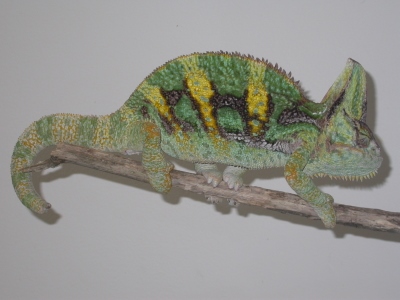
We’re bidding the veiled chameleon a fond farewell now that August is coming to an end. We hope you enjoyed the time we spent together @ExoticPetVets with this colourful creature as our Animal of the Month on Twitter. As always, we are providing a summary of our tweets for you in case you missed any during the month. Did you know?:
- The veiled chameleon (Chamaeleo calyptratus) is found in Yemen and Saudi Arabia.
- There are feral populations of veiled chameleons in Hawaii and Florida because of the pet trade.
- Sometimes the veiled chameleon is known as the Yemen chameleon or the cone-head chameleon.
- The veiled chameleon’s most distinctive physical feature is the large crest on the head. This crest is called a casque.
- The casques on baby veiled chameleons are just small swellings. On adults, casques can be up to 5 cms (2 inches) tall.
- The exact purpose of the casque on the veiled chameleon is unclear.
- It’s believed male veiled chameleons have bigger casques than females so they can threaten other males and attract mates.
- Veiled chameleons are born pastel green. As they mature they sport brighter colours like green, turquoise, yellow and tan.
- Adult male veiled chameleons have bright prominent vertical stripes on their bodies and casques.
- Adult female veiled chameleons have a more muted and mottled appearance.
- In addition to colour and pattern, there is a size difference between male and female veiled chameleons.
- Adult male veiled chameleons can grow to a length of about 40–60 cms (16-24 inches), tip to tail.
- Adult female veiled chameleons are smaller than males, growing to a typical maximum of 33 cms (13 inches).
- Female veiled chameleons have stockier bodies than their male counterparts.
- Despite popular belief, veiled chameleons can’t change into any colour to adapt to their environment.
- Veiled chameleons change their colour to communicate complex messages regarding their emotional and physical states.
- Research shows that veiled chameleon have 14 distinct areas on their skin which can change colour independently.
- Male and female veiled chameleons also communicate different messages when they change colour.
- E.g. female veiled chameleons will change colour to signal if they want (or don’t want) to mate and if they’re pregnant.
- E.g. Male veiled chameleons will change colour when they’re trying to attract a mate or when they’re being aggressive.
- Researchers suggest colour change in male veiled chameleons can help predict who will win a fight.
- Veiled chameleons are omnivorous, meaning they eat both plant and animal material.
- Veiled chameleons mostly eat insects, but to get extra hydration they’ll also eat leaves, blossoms and young shoots.
- Their habitat is shrinking so wild veiled chameleons have moved into agricultural areas and are eating millet.
- As they are slow-moving reptiles, the veiled chameleon’s hunting style is to hide and wait for his prey.
- The veiled chameleon’s eyes can rotate 360 degrees and move independently of each other to help him find prey.
- Their long tongues shoot out at a fraction of a second, allowing veiled chameleons to remain still while catching prey.
- With proper care, male veiled chameleons in captivity can live between 6-8 years.
- Female veiled chameleons have a shorter lifespan than males, living between 4-6 years.
- Female veiled chameleons live shorter lives because producing eggs depletes their energy which impacts their life span.

